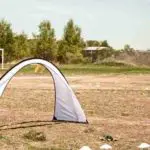Drone cleaning and maintenance is a boring yet important routine. I’ve recently compiled most of the things that a drone pilot would do when it comes to maintenance of drones so that I won’t miss any of that. So here’s how to maintain FPV drones.
To maintain an FPV drone, clean the drone body and check for any obvious damages that require replacement. Run vibration and free spinning tests on your motor. Check the motor shaft, magnetic ring and motor bell. Clean and lubricate the bearing. Then, check the cell balance and internal resistance of your LiPo pack. Tighten every bolt and nut.
Having a drone is like having a car. You need to service it from time to time so that you get the most out of your drone. Let’s look at the details of everything that you need to know about cleaning and maintaining your drones.
Why is Drone Maintenance Important?

First, let’s talk about why it’s important to regularly maintain your drone.
There are a lot of reasons why you should take the extra effort and time to properly service your drone regularly. Here are some of the benefits of doing so:
You’ll be keeping your drone in its top shape.
By making sure that every part of your drone is well-maintained, you’re also keeping your drone in its best shape.
It’s not ideal to fly around a drone with cracked propellers or motors that are not functioning properly. This is especially important if you’re participating in a drone race where the performance of your drone is crucial.
You’ll save more money by preventing future repairs.
For some, maintaining and cleaning your drone can be time-consuming. But the thing is, you’ll save more money and time by making sure your drone is well-maintained and you’re not flying with a broken drone.
If you’re not aware of the small repairs or mishaps that your drone has and you pushed to fly it, then there’s a high risk that the damages will become worse. As a result, you’ll have to spend more money to repair it and spend more time when it comes to service center repairs.
For instance, you can prolong the lifespan of your motors by adequate lubrication; you can also prevent a crash from motor failure if you have identified a damaged motor and change it before the flight.
You’ll have a deeper understanding of drone safekeeping.
When you do your own maintenance and repair regularly, you’ll begin to have a better sense of what to do and what not to do when it comes to handling your drone.
Since you have firsthand experience in cleaning and maintaining your drone, you’ll be more methodical and cautious about how you fly your drone because you already know what certain actions cause certain damages or malfunction.
Preparing the Tools
For an easy and effective way to clean your drone, here’s what you need to have in your kit:
- Soft cleaning brush. Best to have different sizes to accommodate every nook and cranny.
- Canned air. Compressed gas dusters are great to remove dust and other contaminants from hard-to-reach or sensitive areas.
- Pure isopropyl alcohol. Great for cleaning your drone frame and other exterior parts, or even the chips where soap is inappropriate.
- Microfiber cloth. Used for wiping down and removing dust and dirt.
- Cotton bud. Used to clean tight corners and lens.
- Bearing oil or lubricant. This is to lubricate your drone motors, so that they can last longer and run smoother.
- Screwdriver, allen key and long nose plier. You will need them to remove the bolts and nuts so that you can service certain parts.
Things to Look Out For
Now, let’s get to the part of maintaining your drone. Here are the things that you should look out:
Drone Body
Start with cleaning the drone frame. Use a dry brush to gently remove dirt. If there’s any caked dirt or mud, use the microfiber cloth and isopropyl alcohol. For hard-to-reach areas such as narrow joints, use canned air.
Then, do a visual inspection of your drone body. Check for any broken components, fractures, frame twists, or battery straps that are already worn out. Also, check if there are cracks on your props, or if the props are bent.
Motors

Do a visual inspection of the motor first. Check the outer surface of the motors for any major scratches, dings, or dents. The presence of dirt can also affect the performance of your motors.
Clean your motor with a brush. Avoid using water to prevent damaging your motor. Once the motor looks good, go for a couple of checks for maintenance. Here are some of them:
- Motor vibration check. Arm the drone and run the motors (make sure to remove the propellers). Then, use your fingernail to check each motor to feel the vibrations. If it’s vibrating too much, that means that the motor shaft might be bent.
- Free spinning check. To do this, just turn each motor by hand. The rotational friction should be comparable to a brand-new motor, so compare it with your spare one. If the motor shows any sign of stiffness, you might need to apply some bearing oil.
- Shaft straightness check. You don’t want a bent motor shaft. Disassemble the motor and inspect the straightness of the shaft. If it’s bent, then you need to replace it with a new one.
- Inner parts inspection. Check if the magnets are attached securely to the motor bell, and whether they look damaged. Replace your motor if any of those doesn’t look right. Use canned air or blue tack to remove any debris attached onto the motor bell.
- Bearing cleaning. Generally, you don’t have to deal with the bearing. If the bearing looks dirty, wash it with WD40. After that, reapply the bearing oil. You should not use WD40 in place of a bearing oil as it lacks the required viscosity to withstand the heat and provide enough lubrication.
LiPo Battery Check

LiPo battery checks are also important in keeping your drone in tip-top shape. Without properly performing batteries, your drones won’t receive enough power to properly function.
Part of drone battery maintenance is keeping track of your own battery and how you store it. Make sure to label every pack with a designated number and the date of your purchase. In terms of battery checking, here’s what you need to take note of:
- Battery age check. The reason for you to label your batteries properly is to separate the old ones from the new ones. The battery loses its performance over time. Using newer packs will help you maximize the performance of your drone during races and other important flights. But, you can also use the old ones that are still functioning for practice.
- Cell balance check. Use your charger or a LiPo battery meter to check if every cell on your battery packs is balanced. If your battery pack has unbalanced cells, you need to balance it using your charger. But if the battery is constantly becoming unbalanced, then it might be time to dispose of it.
- Internal resistance check. Every battery has its internal resistance. As we use the battery repeatedly, the internal resistance increases. A battery with a high internal resistance loses more energy as heat instead of using the energy to power up your drone when it discharges. That’s why a battery with high internal resistance get hot faster and has a shorter flight time. Because of that, you would want to check the internal resistance of your battery using a battery checker. Replace the LiPo if it gets too high for your battery to be efficient.
If you take care of your LiPo batteries properly, it should be able to last you for a long time.
Battery Checker – ISDT BattGo BG-8S

A battery checker is a nice-to-have tool that allows you to check the condition and health of your LiPo batteries. It shows you the capacity of your battery, the remaining juice, overall and individual cell voltage, maximum charging and discharging rate, temperature, etc.
On top of the basic battery checking feature, the ISDT BattGo BG-8S can also be used to balance the voltage of your LiPo packs, and used to check the signal strength of your radio.
Camera Lens

Camera lens get dirty as you fly, especially if you are using a props-in configuration. Take this opportunity to clean up your camera lens.
Dilute alcohol with water in a 1:1 ratio. Soak the cotton bud with the diluted alcohol and use it to gently wipe the lens. Blow off any cottons that stick on the lens.
Tighten the Loosen Parts
Obviously you need to reassemble what you have opened up for inspection and maintenance. But there are more than that.
Vibration from flights and crashes can slowly loosen the bolts and nuts of your drone. Check all the bolts and nuts on your drone and tighten them. That will include the bolts and nuts on your drone’s arms.
Don’t over tighten the bolts and nuts though. Because of their tiny size, the small groove on the cap and the threads on their body can easily wear out by excessive force.

How Frequent Should I Clean or Maintain My Drone?
There is no fixed rule on the cleaning and maintenance frequency. You should do a quick surface cleaning whenever you think your drone is dirty. As for other maintenance, do that twice a year. If you fly frequently, you probably want to make it a quarterly routine.
Must I Do Everything Stated Above?
Well, you don’t have to do everything, or do them at the same frequency. The items stated above serve as a checklist for you to know what you can do to properly maintain your drone. Just do whatever makes sense for you. For instance, I rarely clean my drone body but I would service the motors more if I fly frequently.
Final Thoughts
FPV drone racing is not a cheap hobby. You’ve probably invested in hundreds, if not thousands, of dollars to create your dream set-up. With such a high value of an investment, wouldn’t you want your drone to serve you as long as possible? Sure, some pilots would let fate take over and fly their drones until its very last second. It is all up to you.


